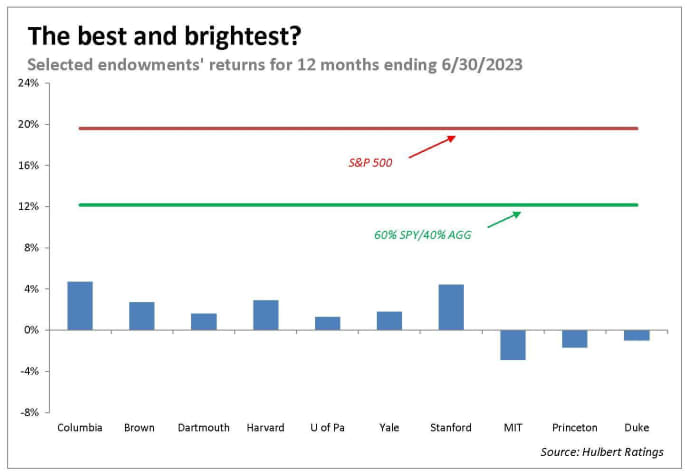Why College and University Endowments Struggle Compared to the Stock Market
October 29, 2023 | by stockcoin.net

Why College and University Endowments Struggle Compared to the Stock Market
In the world of investing, college and university endowments often struggle to keep up with the stock market. As recent data has shown, these institutions have been underperforming when compared to a traditional 60/40 stock-bond portfolio. The reasons for this underperformance are numerous, but one major factor seems to be the shift towards alternative investments. In an attempt to replicate the success of Yale’s endowment in the past, many educational institutions have moved away from public markets and heavily invested in alternative assets. However, this strategy has not yielded the desired results, and endowments are now facing lackluster returns. This article will delve further into the reasons behind this struggle and explore the implications for investors and institutions alike.
▶ [Kucoin] Transaction fee 0% discount CODE◀
Reasons for Struggle
Shift away from public stock and bond markets
One of the main reasons for the struggle of university endowments compared to the stock market is their shift away from public stock and bond markets. In recent years, many endowments have heavily invested in alternative assets, such as private equity and hedge funds, in an attempt to diversify their portfolios and generate higher returns. This shift away from traditional public markets has proven to be a challenge, as the returns from these alternative investments have not been able to match the performance of the stock market.
Overinvestment in alternative investments
Another reason for the struggle of university endowments is their overinvestment in alternative investments. Many endowments have allocated a significant portion of their portfolios to alternative assets, such as real estate, venture capital, and private equity. While these investments have the potential to generate higher returns, they also come with higher risk and greater volatility. The overinvestment in alternative assets has led to closely clustered fiscal-year returns for endowments, indicating that they have been unable to achieve the desired diversification and outperformance.
Comparison of Returns
Low single-digit returns for endowments
The returns of university endowments have been disappointing in recent years, with most of them posting low single-digit returns. According to results released by colleges and universities for their fiscal years ending June 30, the returns of Ivy League university endowments have been in the low single digits or even negative. This is a stark contrast to the 12.2% return of a plain-vanilla 60/40 portfolio, which consists of 60% stocks and 40% bonds. The low returns of endowments indicate that their investment strategies have not been able to keep pace with the broader stock market.
12.2% return for a 60/40 portfolio
In comparison to the low returns of university endowments, a 60/40 portfolio has delivered a much higher return of 12.2%. This portfolio, which consists of 60% stocks and 40% bonds, is a traditional asset allocation strategy that has been widely used by individual investors. The strong performance of the 60/40 portfolio highlights the potential benefits of a diversified investment approach that includes exposure to both stocks and bonds. This comparison further emphasizes the underperformance of endowments and the need to reassess their investment strategies.
▶ [Kucoin] Transaction fee 0% discount CODE◀
Long-Term Performance
Endowments lag behind 60/40 portfolio
The long-term performance of university endowments has also been inferior to that of a 60/40 portfolio. Over the past 5-, 10-, and 15-year periods, the median college and university endowment has lagged behind the 60/40 portfolio by an estimated 2-4% annualized percentage points. This indicates a significant underperformance of endowments over extended periods of time, further highlighting the challenges they face in generating consistent and competitive returns.
2-4% lower annualized returns over 5-, 10-, and 15-year periods
The underperformance of endowments becomes even more apparent when comparing their annualized returns to those of a 60/40 portfolio. With a difference of approximately 2-4% annualized percentage points, endowments have consistently fallen behind the more traditional investment strategy. This gap in performance raises concerns about the effectiveness of endowment investment strategies and the need for adjustments to better align with market trends and investor expectations.
Influence of Yale’s Success
Yale’s endowment success in the 1980s and 1990s
The success of Yale University’s endowment in the 1980s and 1990s has had a significant influence on other institutions’ investment strategies. Under the direction of the late David Swensen, Yale’s endowment achieved remarkable returns by adopting an innovative approach that included a heavy allocation to alternative assets. This success led many other colleges and universities to follow a similar investment strategy, hoping to replicate Yale’s exceptional performance.
Other institutions following Yale’s investment strategy
Following Yale’s success, numerous institutions have adopted a similar investment strategy that emphasizes a low allocation to public markets and a high allocation to alternative investments. For example, Harvard University’s endowment has just 11% invested in public equity and 6% in bonds. This trend is not limited to Harvard, as most college and university endowments have a similarly low allocation to public markets and a high allocation to alternative assets. The widespread adoption of Yale’s investment strategy has contributed to the struggle of endowments and their limited ability to outperform traditional asset allocation approaches.
Allocation to Public Markets
Low allocation to public stock (e.g. Harvard has 11%)
One characteristic of university endowments is their low allocation to public stock. For instance, Harvard University’s endowment has only 11% of its assets invested in public equity. This low allocation to public stock has limited the exposure of endowments to the overall performance of the stock market, which has proven to be a disadvantage as the stock market has experienced significant growth in recent years.
Low allocation to bonds (e.g. Harvard has 6%)
In addition to the low allocation to public stock, university endowments have also maintained a low allocation to bonds. Harvard University’s endowment, for example, has only 6% invested in bonds. This limited exposure to bonds has exposed endowments to a higher level of risk, as bonds have historically provided a more stable and predictable source of income compared to stocks. The low allocation to bonds further contributes to the struggle of endowments to generate consistent and competitive returns.
High Allocation to Alternative Assets
Most endowments have high allocation to alternative investments
One of the significant factors contributing to the struggle of university endowments is their high allocation to alternative investments. Many endowments have allocated a significant portion of their portfolios to alternative assets, such as real estate, venture capital, and private equity. While these investments have the potential to generate higher returns, they also come with higher risk and greater volatility. The high allocation to alternative assets has exposed endowments to the challenges of these investments, including limited liquidity and regulatory restrictions.
Resulting in closely clustered fiscal-year returns
The high allocation to alternative assets has led to closely clustered fiscal-year returns for many university endowments. This means that the returns of different endowments have been similar or even identical, as they have been driven by the performance of a few investment strategies or managers. The closely clustered returns indicate a lack of diversification among endowments and suggest that their investment strategies may not provide the desired level of risk management and return generation.
Impact of Influx of New Money
New money into alternative assets
The influx of new money into alternative assets has had a significant impact on the performance of university endowments. As more institutions have shifted their portfolios towards alternative investments, the supply of available investment opportunities in these asset classes has become more limited. This has resulted in increased competition among investors and reduced the potential for generating significant alpha, or excess returns, from these investments.
Negative effect on endowment returns
The influx of new money into alternative assets has had a negative effect on endowment returns. As the available alpha has diminished, endowments have found it increasingly challenging to generate outsized returns from their investments in hedge funds, private equity, and other alternative assets. This has contributed to their struggle to keep pace with the stock market and has put downward pressure on their overall performance.
Diminishing Returns of Alternative Investments
Illustration by William Bernstein
Illustrating the diminishing returns of alternative investments, financial expert William Bernstein has provided a thought-provoking example. Bernstein asks readers to imagine that approximately $300 billion was invested in hedge funds about 25 years ago, with these funds collectively pursuing around $30 billion of available alpha, or excess return. He explains that these numbers are rough estimates but provide a meaningful illustration. Now, with approximately $3 trillion invested in hedge funds, the excess alpha available has reduced to only 1%. This diminishing excess return is no longer sufficient to cover the high fees associated with hedge funds and has further eroded the performance of endowments heavily invested in alternative assets.
Comparing hedge fund investments from years ago to today
The comparison between hedge fund investments from years ago and their performance today further highlights the diminishing returns of alternative investments. The reduced availability of excess returns, combined with high fees, has made it increasingly challenging for endowments to achieve the desired returns from their hedge fund investments. This diminishing return not only impacts endowments but also raises questions about the effectiveness of alternative investments for individual investors who may be considering incorporating them into their portfolios.
Implications for Individual Investors
Individual investors have not missed out
Despite the struggles faced by university endowments, individual investors have not necessarily missed out on opportunities or advantages. Endowments’ heavy allocation to alternative investments may not be suitable or accessible to individual investors, and their underperformance in recent years suggests that alternative assets may not always deliver superior returns. By taking a more conventional approach and focusing on a well-diversified portfolio that includes both stocks and bonds, individual investors can achieve competitive returns without the need to rely on alternative investments.
Possible advantages of not having access to hedge funds and private-equity funds
Not having access to hedge funds and private equity funds may actually be advantageous for individual investors. These investments often come with high fees and limited transparency, which can erode potential returns and expose investors to unnecessary risk. By focusing on more readily available and transparent investment options, such as index funds and traditional asset classes, individual investors can benefit from a simpler and more cost-effective approach to investing.
Conclusion
University endowments have struggled to keep pace with the stock market for various reasons. The shift away from public stock and bond markets, combined with the overinvestment in alternative assets, has hindered the performance of endowments. The comparison of returns illustrates the underperformance of endowments, with low single-digit returns compared to the 12.2% return of a 60/40 portfolio. The long-term performance of endowments has also lagged behind a 60/40 portfolio, emphasizing the need for a reassessment of investment strategies.
The influence of Yale’s success and the emulation of its investment strategy by other institutions have contributed to the struggle of endowments. Their low allocation to public markets and high allocation to alternative assets have limited their exposure to the broader stock market and led to closely clustered returns. The influx of new money into alternative assets has further impacted endowment returns and reduced the potential for generating excess returns.
The diminishing returns of alternative investments, as illustrated by William Bernstein, highlight the challenges faced by endowments and call into question the effectiveness of these investments. However, individual investors have not missed out on opportunities, and there may be advantages to not having access to hedge funds and private-equity funds. By focusing on a well-diversified portfolio and avoiding the complexities and high fees associated with alternative investments, individual investors can achieve competitive returns without the need for exposure to these assets.
▶ [Kucoin] Transaction fee 0% discount CODE◀

RELATED POSTS
View all







